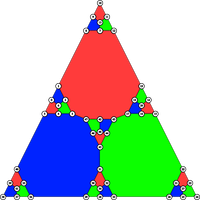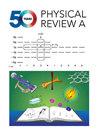Concatenated Steane code with single-flag syndrome checks
IF 2.9
2区 物理与天体物理
Q2 Physics and Astronomy
引用次数: 0
Abstract
A fault-tolerant error correction (FTEC) protocol with a high error suppression rate and low overhead is very desirable for the near-term implementation of quantum computers. In this work, we develop a distance-preserving flag FTEC protocol for the concatenated Steane code, which requires only two ancilla qubits per generator and can be implemented on a planar layout. We generalize the weight-parity error correction (WPEC) technique from Tansuwannont and Leung [Phys. Rev. A 104, 042410 (2021)] and find a gate ordering of flag circuits for the concatenated Steane code, which makes syndrome extraction with two ancilla qubits per generator possible. The FTEC protocol is constructed using the optimization tools for flag FTEC developed in Pato et al. [PRX Quantum 5, 020336 (2024)] and is simulated under the circuit-level noise model without idling noise. Our simulations give a pseudothreshold of for the concatenated Steane code, which is better than a pseudothreshold of for the 6.6.6 color code simulated under the same settings. This is in contrast to the code capacity model where the code performs better.

带有单标志综合征检查的串联 Steane 代码
容错纠错(FTEC)协议具有较高的错误抑制率和较低的开销,是近期实现量子计算机的理想选择。在这项工作中,我们为[[49,1,9]]串联的 Steane 代码开发了一种保距标志 FTEC 协议,每个发生器只需要两个 ancilla 量子位,并且可以在平面布局上实现。我们推广了 Tansuwannont 和 Leung [Phys. Rev. A 104, 042410 (2021)]的权重奇偶纠错(WPEC)技术,并为串联 Steane 码找到了标志电路的门排序,这使得每个发生器只需两个 ancilla 量子位就能进行综合征提取。FTEC 协议是利用帕托等人[PRX Quantum 5, 020336 (2024)]开发的旗语 FTEC 优化工具构建的,并在电路级噪声模型下进行了模拟,没有空转噪声。我们的模拟结果表明,[[49,1,9]] 连接的 Steane 代码的伪阈值为 1.64×10-3,优于[[61,1,9]] 的伪阈值 1.43×10-3。6.6.6]色码的伪阈值 1.43×10-3。这与[[61,1,9]] 码的容量模型形成鲜明对比,[[61,1,9]] 码的表现更好。
本文章由计算机程序翻译,如有差异,请以英文原文为准。
求助全文
约1分钟内获得全文
求助全文
来源期刊

Physical Review A
物理-光学
CiteScore
5.40
自引率
24.10%
发文量
0
审稿时长
2.2 months
期刊介绍:
Physical Review A (PRA) publishes important developments in the rapidly evolving areas of atomic, molecular, and optical (AMO) physics, quantum information, and related fundamental concepts.
PRA covers atomic, molecular, and optical physics, foundations of quantum mechanics, and quantum information, including:
-Fundamental concepts
-Quantum information
-Atomic and molecular structure and dynamics; high-precision measurement
-Atomic and molecular collisions and interactions
-Atomic and molecular processes in external fields, including interactions with strong fields and short pulses
-Matter waves and collective properties of cold atoms and molecules
-Quantum optics, physics of lasers, nonlinear optics, and classical optics
 求助内容:
求助内容: 应助结果提醒方式:
应助结果提醒方式:


